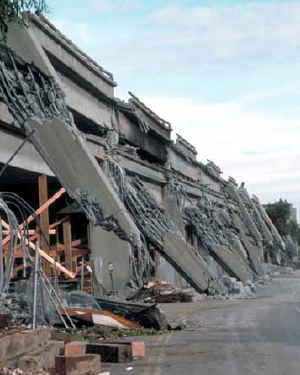Recalling the Loma Prieta earthquake and Mac advantages


Within hours following the 6.9 magnitude earthquake (I still say it was 7.1 magnitude), volunteers of the Berkeley Macintosh User Group gathered Macs, printers and software to help the Red Cross emergency effort. Raines Cohen, one of the founders of the group, led the team of volunteers to quickly create network of computers and craft a database to help coordinate damage reports and resources.
This quick action was made possible by two mostly-Apple technologies: transparent networking protocols and GUI database tools. It's hard to imagine today when these features have become ubiquitous in all computers and even most consumer computing devices. But in 1989, these capabilities weren't standard even in business machines.
AppleTalk networking was developed by Apple for the Macintosh computer. The concept was a transparent client/server local area network that would let multiple users to share files and printers. However, unlike most networking employed at the time, it required almost no user interaction or dedicated server; it was invisible to Mac users. You plugged in a cable and opened a control panel and there were the resources.
BMUGers had a lot of experience with AppleTalk (later LocalTalk) since the group developed BMUGNet, an adapter that could use twisted-pair telephone wiring for AppleTalk networks. The product was commercialized by Farallon Computing as PhoneNet. (Farallon was renamed Netopia and is now owned by Motorola).
Cohen recalls that volunteers poured in using Macs from the user group's office and networking equipment from Farallon. He's now a Berkeley-based consultant and community organizer. "It was a volunteer renegade MIS department working around the clock. We worked out of the same Red Cross facility in Oakland supporting the rescue workers on the Cypress structure. My Mac at the time was a Mac Plus with some enhancements, if I recall correctly, and I dragged it in a backpack and bicycled down to the Red Cross," he said.
In addition, the Loma Prieta earthquake hit Apple's networking group hard, as I wrote at the time. The DeAnza 3 building, which housed much of Apple’s system software and networking and communications development groups, was totally ripped apart. The projects there were shifted to other facilities until a new home was constructed more than a year later.
We can see the legacy of AppleTalk's concepts of convenience in Apple's Bonjour networking, which lets wired and wireless networking devices as well as local hosts broadcast their availability and then allowing users connect easily to resources. This capability is integrated into Mac OS X (and there's also a Bonjour Setup Wizard for Windows).
For its database, the BMUG team used FileMaker II, then developed by Claris, Apple's wholly-owned software subsidiary. The program provided an easy interface to create complex forms that were still easy for folks punching in data to understand. And reports were able to be quickly generated for rescue workers and managers in the field. (Claris reformed as FileMaker Inc. in the late 1990s and passed its non-database titles back to Apple.)
"There was an attempt at using a [then ACI US] 4D database to analyze damage-assessment data, but we were rushing so fast, coding into the night. It was challenging, plus the 4D system was limited to just the professional, trained gurus, while the FileMaker system was much more user-modifiable. We could evolve it as we worked," Cohen recalled.
When the earthquake hit, the Red Cross had almost no on-site computing capability for emergencies at the time. Of course, "business computing" in those days was mostly based on mainframes and minicomputers. And forget a GUI — PCs were still all DOS.
Of course, today we all expect and demand a GUI, except for servers. Apple is doing something about that situation with its forthcoming Leopard Server release. (I will have more to say about this shortly.)
But note, then, as today, the Mac was criticized for its "unnecessary extras." For some reason, less is more and cheaper is always better in the PC mindset. Apple continues to pack its machines with technology.
And still today, these "extras" are the things that let the Mac, it's OS and software be so valued by customers. Then as now, the Mac is easy to use, flexible and convenient. And sometimes, it can save the day.